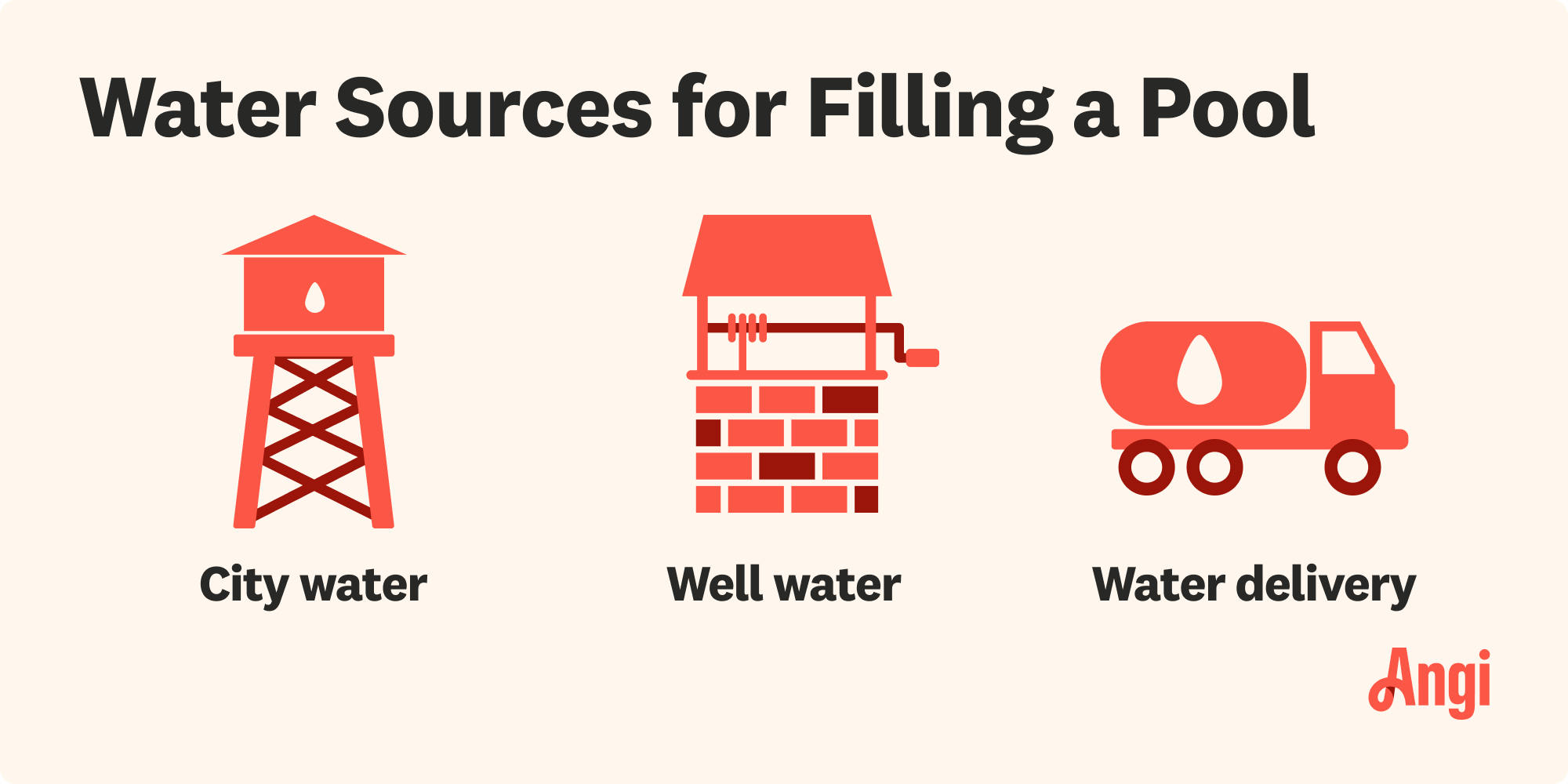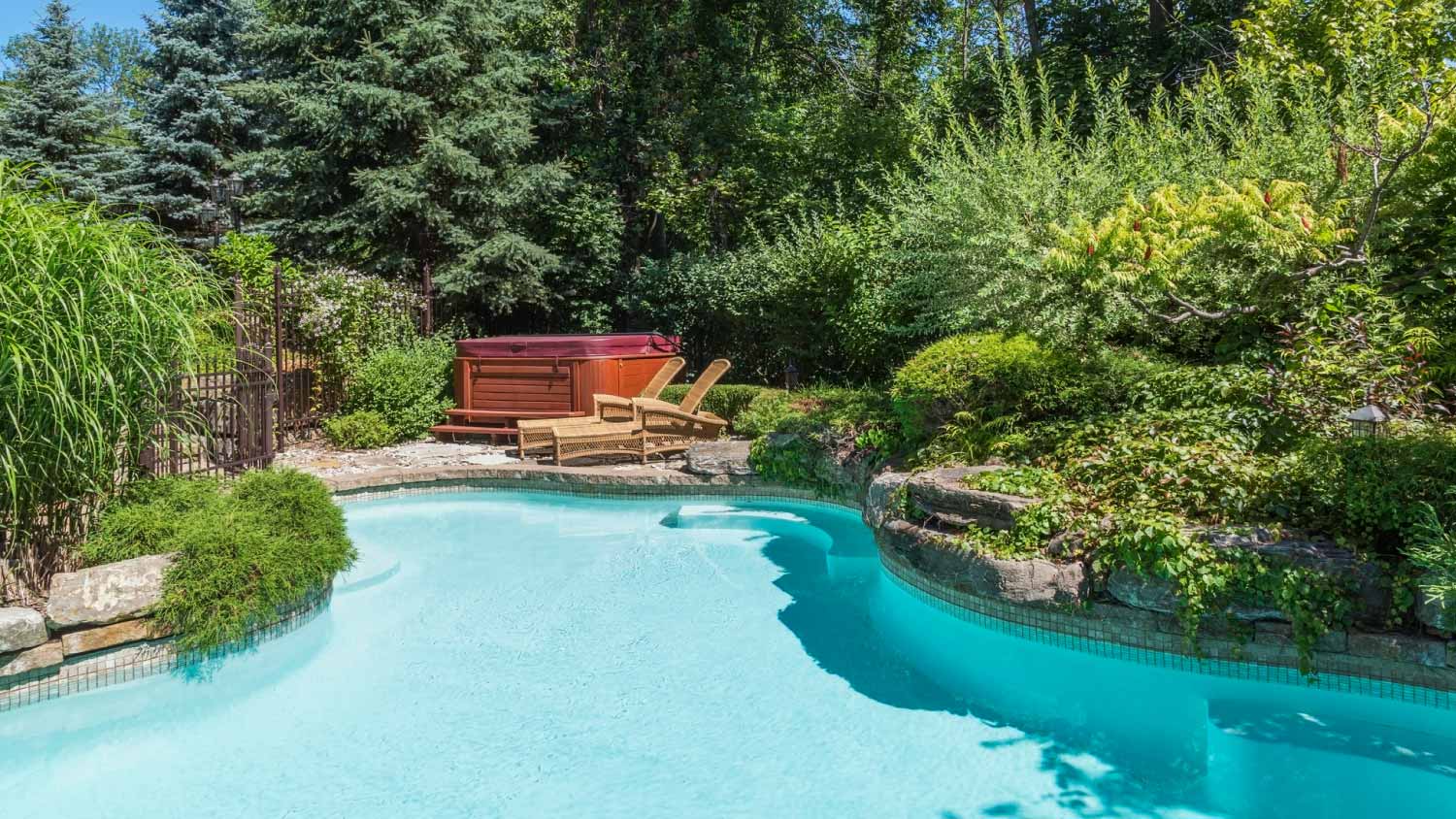
Semi-inground pools offer a nice balance of convenience and affordability. Use this guide to estimate semi-inground pool costs to transform your backyard.
You’ll be perfecting your cannonball in no time


You've got your dream pool installed in the backyard, with an updated deck and fresh landscaping to boot. Now you just need the crucial finishing touch—pool water. When it comes to pool water delivery, you can choose between a pool filling service or your handy hose. Read on to learn how to fill a pool with water, including how much the different methods cost and how to calculate the amount of water you'll need.

There are a few different ways to fill up your swimming pool, and your choice will depend mostly on where you live, the size of your pool, and how much you want to budget for the cost of filling a pool.
If your property gets water from the city, you can fill up your pool with the garden hose. Just prepare for a hefty water bill and several days of time spent filling the pool. City water costs about $0.004 per gallon on average, so your bill will cost $60 to $120 if you fill a 15,000- to 30,000-gallon swimming pool with city water from your garden hose.
While some municipalities may offer pool credits once per year to refill a pool or reduced rates for filling a pool, other cities in drought-stricken areas like California or Nevada may have fines or higher charges for using city water to fill a swimming pool.
For people who have well water to supply their property, using this source of water can be a budget-friendly option for filling a swimming pool, depending on its size. Like with city water, well water is best suited for filling kiddie pools or small pools, since your well could be at risk of running dry while trying to fill a larger pool.
With well water, you won’t need to pay for water, but you will need to pay for the electricity to power the pump that moves the water from underground to the hose and to the pool. It’s more affordable than paying for city water, though. Keep in mind that well water can sometimes be more challenging to balance, especially when it comes to pH.
After you install or de-winterize your pool, your family is probably excited to jump in. When you don't want to wait several days or deal with more intensive balancing with the city or well water, you can hire a pool water delivery service to truck water to your pool.
While this option is more expensive, at about $1,250 to $1,900 for a 30,000-gallon pool, it is quick. In terms of effort, it only requires you to call and make an appointment for the pool water delivery.

| City Water | Well Water | Water Delivery |
|---|---|---|
| Low-cost option | Low-cost option | Higher up-front cost |
| Filling takes a few days | Filling takes several days | Takes a few hours |
| May have additional fees | Risk of well running dry | Available pretreated with chemicals |
| Ideal for areas not prone to drought | Electricity charges for well pump | Available in city or rural areas |
| Good for small to medium pools | Good for small pools | Good for medium to large pools |

Pools require different amounts of water based on their size and shape. A DIY aboveground pool from the store should tell you how much water it holds on the package or owner’s manual. If you no longer have the information or have a custom in-ground pool, you can also calculate the amount of pool water you need using a few simple formulas.
To find out how much water you’ll need for a round pool, use the following formula after measuring from one side of the pool coping to the other:
Diameter Length (A) x Diameter Length (A) x Average Depth x 5.9 = Total Water Volume
Be sure to use the average depth of the pool for pools with shallow and deep ends.
For an oval pool, use the following formula (using average total depth for pools with varying depths):
Length (A) x Width (B) x Average Depth x 5.9 = Total Water Volume
You can use the following formula to determine the water volume of a rectangular pool:
Length (A) x Width (B) x Average Depth x 7.5 = Total Water Volume
| Type of Pool | Formula for Total Water Volume |
|---|---|
| Round | Diameter Length (A) x Diameter Length (A) x Average Depth x 5.9 |
| Oval | Length (A) x Width (B) x Average Depth x 5.9 |
| Rectangular | Length (A) x Width (B) x Average Depth x 7.5 |
If you want to reduce pool water delivery costs to save up for a diving board or extra pool floats, there are some tips and tricks to spending less on water. Here are four ways to decrease water delivery costs up front and over time.
Maybe you don’t have enough time to fill a pool with city water, or you don’t want your well to run dry while filling the pool. You can save money by having a lower amount of water delivered by a water service, then mix it with city or well water for a lower overall cost.
To get the best value, it’s a good idea to get quotes from at least three swimming pool companies for pool water delivery. Some companies may offer off-season deals, returning customer discounts, first-time service discounts, or other perks. You may also want to choose a company with pretreated water to save money on chemicals to treat the water yourself.
Pools naturally evaporate over time. In peak summertime, pools can lose about 1/4 inch of water per day. While you can’t completely prevent pool water evaporation, you can slow it down with a pool cover. Place the pool cover over the pool while it isn’t in use to help reduce evaporation and extend the amount of time between water refills.
A leaking pool will not only have you refilling the pool more frequently, these leaks can also lead to extensive water damage around your yard and home, and they can damage your pool’s structure as well, potentially leading to costly repairs. Check for signs of pool problems, like above-normal water loss or visible cracks or tears in the concrete, tile, or vinyl liner.
If you suspect or identify a pool leak, hire a pool repair specialist near you to make the necessary repairs so that you can get back to floating and relaxing as soon as possible. Pool repairs cost an average of $700 but are well worth it for a swimmable summer.
Whether you bust out the hose and fill your pool yourself or call a delivery company to do it comes down to a few key factors, including your location and how quickly you need the pool to be ready. Consider the following before deciding:
Your pool size: Small pools are often suitable for DIY filling, but filling a large pool yourself will take days or even weeks. You may incur extra fees if you fill a large pool with city water, and if you have well water, it could put undue pressure on your well pump.
The climate in your area: If you live in a dry climate that is prone to droughts, it’s probably best to hire a professional to deliver pool water. You’ll put less strain on the environment and could avoid hefty fines for using large amounts of water.
How long you’re willing to wait: If you’re not in a rush to start swimming, filling your pool yourself might be a more affordable option. But if you already have your first pool party on the books, hire a professional for expediency. Some will even deliver treated water to get your pool ready for action immediately.
If your pool is new, talk to your local pool installer and ask if they plan to fill the pool and if it’s included in your estimate. You can also ask them for assistance with calculating how much water you’ll need.
From average costs to expert advice, get all the answers you need to get your job done.

Semi-inground pools offer a nice balance of convenience and affordability. Use this guide to estimate semi-inground pool costs to transform your backyard.

Considering a swimming pool for your backyard? Find out everything you need to know about in-ground pool costs, from materials to labor and more.

From small leaks to broken pool pumps, how much do pool repairs cost? We'll break down what to expect from your pool repair bill no matter the size of the fix.

When a murky mess interrupts your morning laps, you need to know how to clear cloudy pool water fast. These top cloudy water fixes will keep you afloat.

How much shock does my pool need? Here's how to calculate how much pool shock to add to your pool based on its overall water condition.

A broken pool light can be dangerous as well as inconvenient. Learn who to call to fix your pool light safely and correctly.